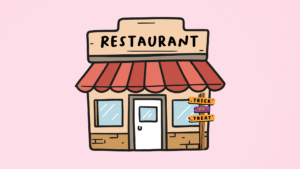Technology today has provided the hospitality and retail industries with an endless array of omnichannel engagement options for communicating with customers, from Tweets and push notifications to emails and face-to-face interactions.
But as the ease of reaching customers has increased, so too have customer expectations regarding the quality of that communication.
According to Zendesk [1], 87% of customers think that brands to need to work harder to create a seamless experience, underlining the importance of true omnichannel engagement. That means, not only providing a consistent branding experience across all physical and digital channels, but providing consistent customer service, as well as optimal ordering and payment experiences.
Online Giants and Omnichannel Engagement
Certain fast casual and retail chains have taken omnichannel to heart, with Starbucks serving as a prime example: The coffee behemoth now takes in 30% of transactions via mobile payment thanks to its mobile ordering platform, which allows customers to order and pay ahead of time to skip the line [2].
Paired with the app’s linkage to Starbuck’s wildly popular customer loyalty program, this level of convenience through omnichannel engagement has pushed Starbuck’s payment system ahead of even Apple Pay in terms of usage.
Others, however, still have some work to do, and they can look to online giants like Amazon — as well as Bonobos, Casper, Blue Apron and Plated — as examples. These companies conquered the online arena before moving into the world of brick-and-mortar operations, and they became masters of omnichannel engagement in the process. Here’s how they did it.
Amazon: A Logged-In Approach
Amazon’s purchase of Whole Foods in 2017 not only brought the online giant an entirely new brick-and-mortar revenue stream; it also brought the company a goldmine of customer data [3]. Harmonizing its approach across all channels, Amazon offers its Prime members special deals in Whole Foods stores and online.
To receive those in-store deals, customers are required to log in to the Whole Foods app and present a QR code to the cashier, which, in turn, provides data to Amazon about customers’ shopping habits.
Not only do customers get an enhanced shopping experience; Amazon gets valuable information about its most loyal customers to use later for target marketing.
Learn More: Beyond Mobile Payments: 5 Ways to Engage Your Customers Post Purchase
Bonobos: Personalization
Bonobos launched in 2012 as an online retailer focused on men’s pants, but just 5 years later, Walmart purchased the company for $310 million, enabling a robust omnichannel strategy [4].
Today, Bonobos has 48 brick-and-mortar “guideshops,” where a customer can meet with a stylist by appointment, try on clothing, create a style profile and make a purchase online — but cannot take anything home. Instead, the clothing is delivered to his door, and his style preferences and measurements are saved to make the future online shopping experience highly personalized.
The new tactic has proven successful, with a larger average order size coming from the guideshops and customers more likely to make repeat transactions and less likely to make returns.
Casper: Consistency and Continuity
The market for online mattress sales is rife with competition, with easy-to-ship mattresses like Leesa, Purple and Tuft & Needle quickly gaining in popularity. But, despite these companies’ offers of free returns, many customers are hesitant to buy a mattress without giving it a bounce or two first.
Casper has managed to differentiate itself from the pack with pop-up stores, retail locations and, as of last year, a partnership with mega-retailer Target. Customers are now able to test out Casper mattresses and pillows in 1,200 Target stores and in 18 Casper stores, with plans to open a total of 200 of its own stores over the next three years [5].
This omnichannel engagement strategy offers buyers a consistent experience in-store and online in terms of pricing, branding and customer s. (No matter where they shop, all buyers receive a 100-night risk-free trial.) That continuity seems to be paying off.
According to Casper’s CEO, customer acquisition costs have fallen over the past year, thanks in part to its brick-and-mortar openings, while sales have grown more quickly in markets where the company operates physical stores.
Blue Apron and Plated: Convenience
According to Nielsen, only 9% of US households have tried a meal kit, comprised of raw ingredients and recipes delivered to customers’ doors for at-home cooking, yet 70% of households know that they exist [6].
So what’s the barrier to entry? Companies like Blue Apron and Plated are betting that it’s the online ordering subscription model, and each have begun to sell individual meal kits in grocery stores to remedy the problem [7,8].
Simply put, it’s a strategy of meeting potential customers wherever they may be, on their own terms, and it’s one that applies to both online giants and more traditional hospitality and retail chains. The convenience to customers of being able to grab a quick meal off shelves without having to buy into a larger subscription program seems promising: Blue Apron’s shares jumped as much as 5.6% after The Wall Street Journal reported the move.
Making the Most of Omnichannel Engagement
Optimized experience for your customers involves consistent branding and customer service, convenience, and a targeted and personalized approach to marketing.
According to research, providing this sort of seamless customer experience pays of: Aspect Software found that businesses adopting omnichannel strategies achieve 91% greater year-over-year retention compared to businesses that don’t [9].
In order to truly thrive in the modern economy, brick-and-mortar businesses must look to the online giants, adopting omnichannel engagement tools and tactics, to provide the best customer experience across both digital and physical realms.
For more tips and best practices on making omnichannel work for you, check out our 3 Ways to Optimize the Omnichannel Experience for Diners.
Como Sense is a customer management platform that integrates with your POS system to keep track of customers, analyze their behavior and then motivate them to come back and spend more. Create a comprehensive omnichannel engagement strategy with Como by building loyalty programs, mobile apps, marketing automations, SMS campaigns, and so much more.
Ready to build a seamless omnichannel experience for your customers? Download our free guide to learn how to adopt a winning omnichannel engagement strategy for your business
Sources:
1. http://d16cvnquvjw7pr.cloudfront.net/resources/whitepapers/Omnichannel-Customer-Service-Gap.pdf
2. https://digit.hbs.org/submission/starbucks-mobile-app-a-winner-in-bridging-the-retail-digital-divide/
3. https://www.businessinsider.com/amazon-buys-whole-foods-changes-2017-8
4. https://www.nytimes.com/2017/06/16/business/walmart-bonobos-merger.html
5. https://www.wsj.com/articles/casper-a-web-pioneer-to-open-200-stores-1533729600
6.https://www.foodnavigator-usa.com/Article/2018/03/22/The-future-of-meal-kits-is-omni-channel-says-Chef-d-with-meal-kits-to-hit-1-500-stores-by-the-end-of-May
7. https://www.forbes.com/sites/maggiemcgrath/2018/03/15/following-15-decline-in-customer-count-blue-apron-seeks-to-sell-its-kits-in-grocery-stores/#65a001862646
8. https://www.fastcompany.com/40484473/at-plated-the-future-of-meal-kit-services-is-grocery-stores
9. https://loyalty360.org/content-gallery/daily-news/survey-businesses-that-use-omni-channel-strategies-have-far-better-customer
Posted by
Liran Mayost
Liran heads Como’s Product and R&D divisions, responsible for developing the product strategy and roadmap, and overseeing all aspects of research, development, business intelligence, and innovation.




